Are you interested in collecting Draped Bust silver dollars? Are you particularly curious about the 1800 silver dollar value? Then, you’ve come to the right place!
This guide will walk you through everything you need to know about this historical coin, including its interesting history and standout features. You’ll also find expert grading tips and fascinating minting errors and die varieties that are worth a small fortune!
The 1800 silver dollar has one of the lowest mintages in the entire Draped Bust silver dollar series; examples often command premium prices and can be an excellent addition to your collection.
So, without further ado, let’s find out: how much is an 1800 silver dollar worth?
1800 Silver Dollar Value Chart |
||||
| Mint Mark | Good | Fine | Extremely Fine | Uncirculated |
| 1800-No Mint Mark Silver Dollar Value | $1,085 | $1,800 | $4,600 | $230,000 |
History of the 1800 Silver Dollar
The 1800 silver dollar is part of the Draped Bust dollar series, which the United States Mint struck between 1975 to 1803, after which, the 1804 dated silver dollars were minted until the 1850s. The Draped Bust replaced the Flowing Hair dollar design, the first silver dollar produced by the Mint and which lasted for just one year.
When the Mint first struck the Flowing Hair dollar, it was also the first time that an official mint was set up in the country. The Coinage Act of 1972 had established that silver coins minted in the U.S. should contain 89.2% silver and 10.8% copper. However, for some reason, Mint officials found this ratio to be odd and opted to strike the 1974 silver dollars in 90% silver although this came at a loss for silver depositors.
In 1975, production of the Flowing Hair design was halted and it is believed that Director of the Mint, Henry William de Saussure, ordered a redesign of the silver dollar. At the same time, there had been mounting public disapproval of the Flowing half dollar, prompting a change in design.
Artist Gilbert Stuart created the Draped Bust design, which is thought to have been inspired by or modelled after Philadelphia socialite Ann Willing Bingham. De Saussure and the Mint Engraver, Robert Scot approved Stuart’s initial sketches and sent them to President George Washington and Secretary of the State Thomas Jefferson, who also gave a final nod to the proposed designs.
Production of the silver dollar began in late 1795 and just around the same time, de Saussure was replaced by a new Mint Director, Elias Boudinot. Boudinot immediately instructed that the new silver dollars be struck in accordance with the provisions of the Coinage Act of 1792. In 1798, the reverse design was changed from the small eagle to a larger eagle design as shown in the Great Seal of the United States.
Mintage numbers of the 1799 silver dollar remained higher than in previous years, which had seen a drastic decline in production. But, production began to decline again in 1800 due to a reduction in silver deposits. By 1804, the Mint ended the coinage of silver dollars due to the dwindling supplies of silver deposits and instead began focusing on smaller denominations.
Its low mintage and historical status make the 1800 silver dollar valuable and a great addition to any collection.
Also read: 12 Most Valuable One-Dollar Coin Worth Money
Features of the 1800 Silver Dollar
Understanding the physical attributes of the 1800 silver dollar is essential for grading and authenticating your coin. Also, knowing these features can help you spot high-value silver dollars.
Obverse of the 1800 Silver Dollar
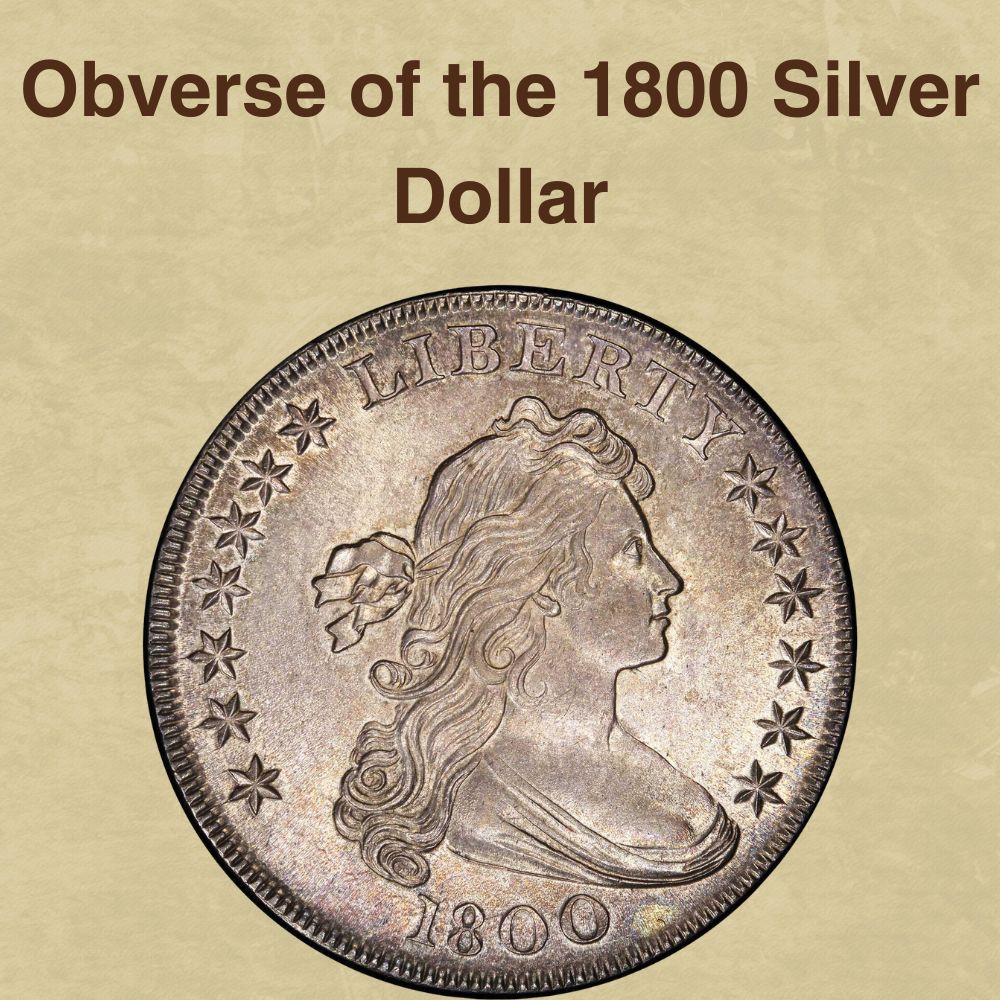
The front side features a right-facing Liberty draped in a flowy dress or blouse that slightly exposes her bust while her hair flows freely.
The word LIBERTY is etched above her while the date, 1800, is shown at the bottom. Thirteen stars, seven on the left and six on the right, encircle Liberty’s portrait. The stars represent the first thirteen states to join the Union.
Reverse of the 1800 Silver Dollar
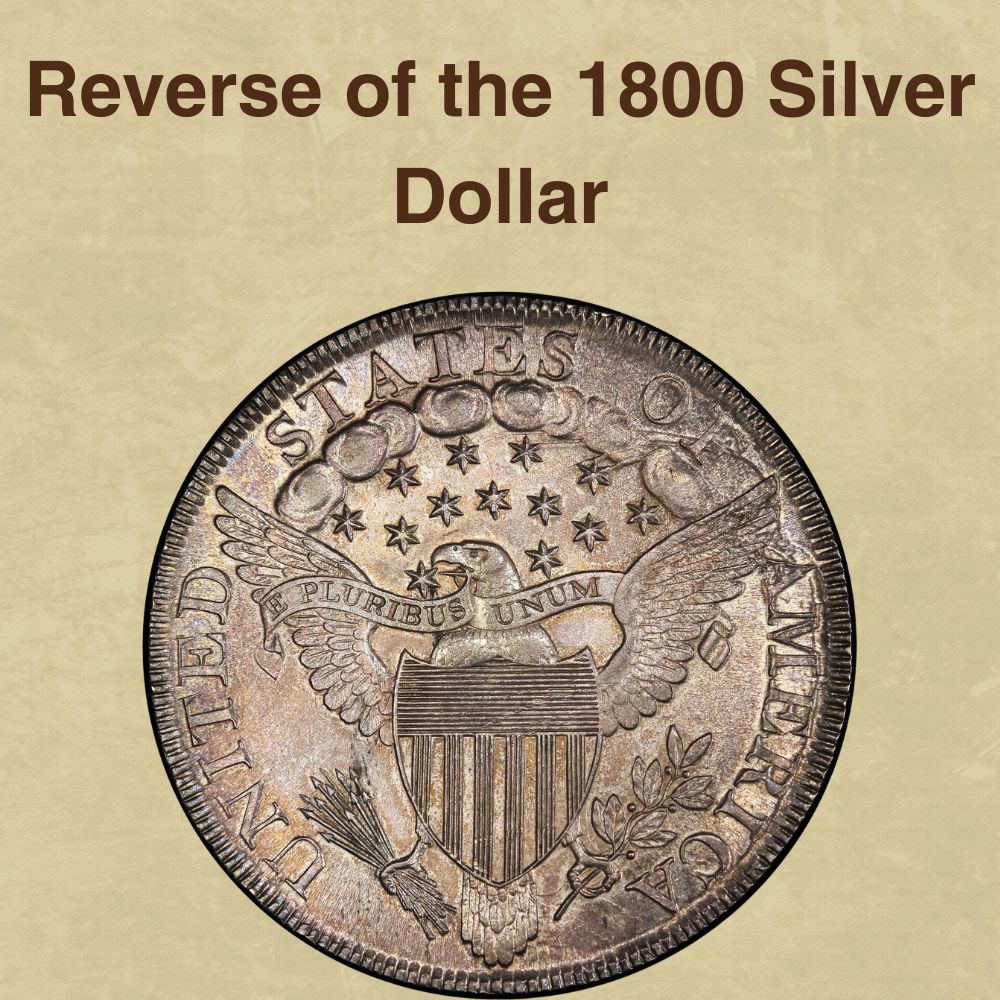
The reverse shows a heraldic eagle with wings stretched out. In its beak, the eagle holds a flag with the Latin inscriptions, E PLURIBUS UNUM (out of many, one).
The eagle also holds a bunch of arrows in its left talon and an olive branch in the right one, symbolizing protection and peace. A shield on the eagle’s chest represents sovereignty.
A constellation of eleven stars in a six by five arrangement, and a billow of clouds appear above the eagle’s head, representing the original states. The words UNITED STATES OF AMERICA are etched around the coin’s circumference.
Other Features of the 1800 Silver Dollar
Additional notable features of the 1800 silver dollar include:
- Diameter: 40.00 millimeters
- Weight: 27.00 grams
- Edge: HUNDRED CENTS ONE DOLLAR OR UNIT
- Metal Composition: 89.2% Silver, 10.8% Copper
- ASW: 0.7731oz
- Fineness: 0.7731oz
Also read: 14 Most Valuable Coins In Circulation
1800 Silver Dollar Value Guides
Let’s now find out: How much is an 1800 silver dollar worth? This coin’s value mostly depends on the condition. Circulated examples are fairly common but will fetch premium prices even in lower grades due to the coin’s historical status.
There’s only one variety of the 1800 silver dollar: 1800 no-mintmark silver dollar.
Let’s find out more about this coin’s value.
1800 No-Mint mark Silver Dollar Value
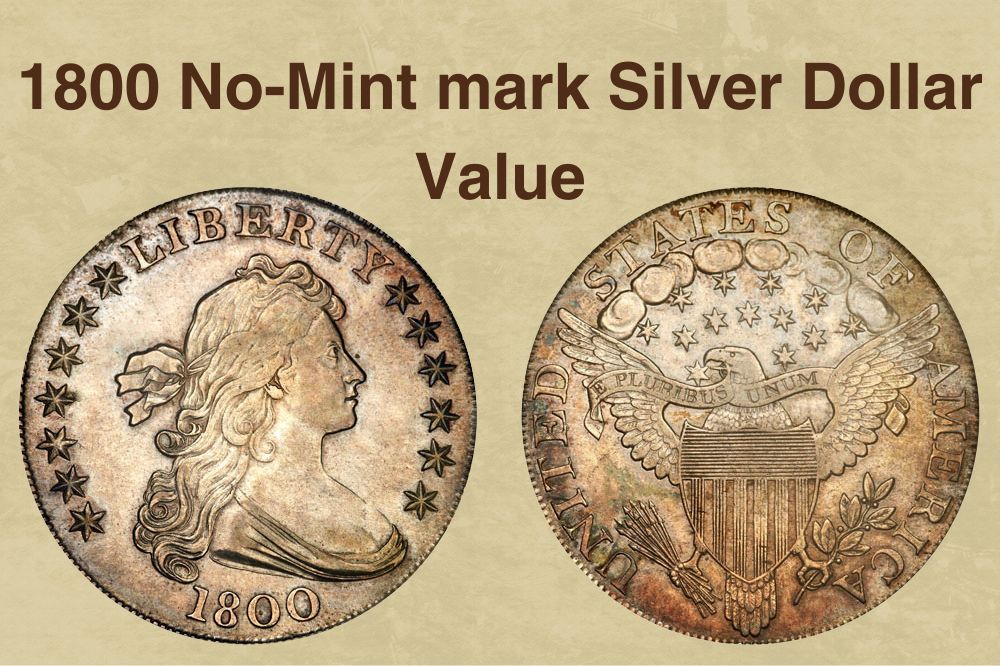
The Philadelphia Mint struck about 220,920 silver dollars in 1800, one of the lowest mintages since production began in 1795. Circulated pieces are fairly common though the majority are heavily worn due to age-related damage or attrition.
Here’s a breakdown of the circulated and uncirculated values:
Circulated Examples: These are relatively common but survivors are heavily worn, even in higher grades. On the upside, if you are lucky enough to come across one of these ancient coins, you might be able to sell it for a premium depending on its condition. An example graded Good(G) will sell for as much as $1085, a Fine (F) one for as much as $1800 while an Extremely Fine (XF) and About Uncirculated (AU58) for will fetch at least $4600 and $10,000 respectively.
Mint State Examples: Uncirculated 1800 silver dollars are hard to come by and will often command premium prices even in lower grades. For example, a piece graded MS60 will sell for at least $26,000 while an MS63 can bring in up to $62,500. Any examples graded MS64 and higher are genuinely rare, attracting premiums of up to $132,500 while an MS65 can command up to $230,000.
Auction Record: In 2020, Legend Rare Coin Auctions sold an MS65+ for an impressive $246, 750, making this the most expensive 1800 silver coin to date.
Also read: Top 10 Most Valuable Morgan Silver Dollar Worth Money
1800 Silver Dollar Grading
Grading an 1800 Draped Bust silver dollar can be challenging because most survivors are heavily worn. The process requires close attention to detail because even slight variations in the design elements can affect the coin’s grade and value.
First, assess the strike quality and sharpness of the features. Evaluate Liberty’s features, including the drapery, cheek, forehead, hair, and top of the bust for signs of wear. In lower-grade circulated examples, these features will show heavy wear. Also, pay attention to the crispness (or lack of) of the inscriptions including the word LIBERTY and the date, 1800, which should be clear and readable on higher-grade coins.
On the reverse, key contact points to look at include the eagle’s feathers and wings and the star arrangement. On high-grade 1800 silver dollars, these will have a strong, distinct strike and a more flattened, weaker strike on lower-grade silver dollars. Also, check the extent of wear on the words UNITED STATES OF AMERICA.
In addition to strike quality, pay attention to the luster, toning, and surface marks. Higher-grade examples will have the original mint luster or at least some shininess even on circulated coins. Look if the coin has marks, scratches or dings on the surface, which is typical of lower, circulated example. Higher-grade coins will have little to no surface marks or toning issues.
Finally, it’s recommended to consult a grading service such as the Professional Coin Grading Service (PCGS) or the Numismatic Guaranty Company (NGC). These services provide more accurate grading and authentication of your 1800 silver dollar.
Rare 1800 Silver Dollar Errors List
When it comes to Draped Bust minting errors, we’ll focus on the die marriages, which resulted in some peculiar design differences among the coins produced. In 1800 for example, 16 different die marriages were used to produce the resulting silver dollars.
Numismatists M.H. Bolender and later Q.D. Bowers identified the 1800 silver dollar die varieties. These varieties are abbreviated as BB, after the coin specialists. We’ll only look at the major ones here.
1. BB-191/2 (Bolender-19)
This is the most sought-after die error in the Draped Bust silver dollar series, in which there’s an extra “I” at the end of the word AMERICA on the reverse, resulting in the word reading “AMERICAI.”
The exact cause of the error is unknown but possibilities include a die break, misplaced or double punch, or a spacing issue after attempting to correct a misaligned or weak letter.
Circulated examples of the “AMERICAI” die variety sell for as much as $1,420 while Mint State examples can command up to $30,000 or more.
2. BB-196 (Bolender-16)

This die variety is considered the most perfect in the 1800 silver dollar series due to its sharp strike and overall balance. Liberty’s bust is well defined with fine, sharp details and so is the eagle on the reverse. Due to its perfect details, the BB-196 often attracts the highest prices ranging from $10,000 in graded Good (G) to Fine (F) to $35,000 or more in graded Extremely Fine (XF) to About Uncirculated (AU58).
3. BB-186 (Bolender-8)

This variety features the number 0 in the date at a slightly lower position than the rest of the digits. On the reverse, the eagle’s left talon shows a sharper outline than in other varieties. The BB-186 is scarce in higher grades and will command equally premium prices ranging from $4,000 to $15,000.
4. BB-184 (Bolender-4)
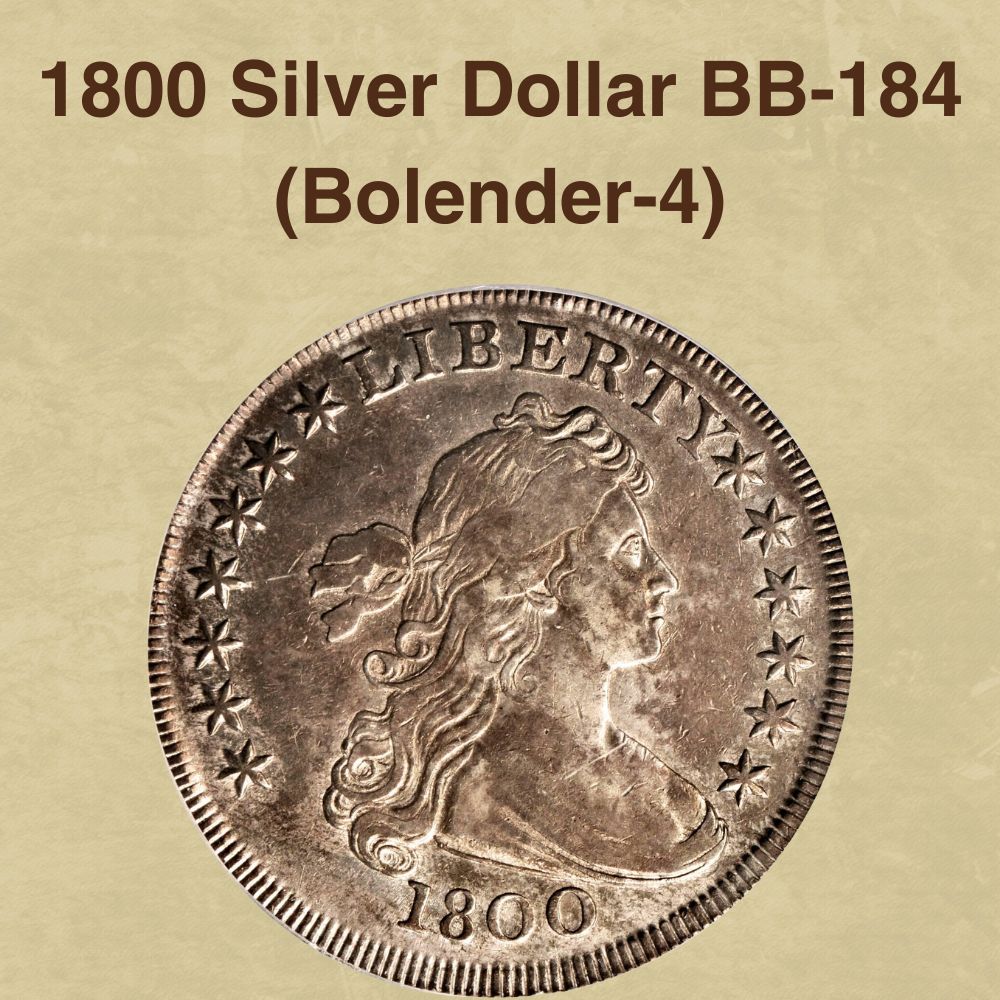
There’s even spacing between the numbers in the date, with the number 1 close to Liberty’s hair curl. On the reverse, the eagle’s tail feathers appear longer and there’s noticeable spacing between the inscriptions. A BB-184 is relatively rare and will usually fetch more—values range from $5,000 to $20,000 for circulated examples graded Good (G) to About Uncirculated (AU58).
5. BB-182 (Bolender-2)
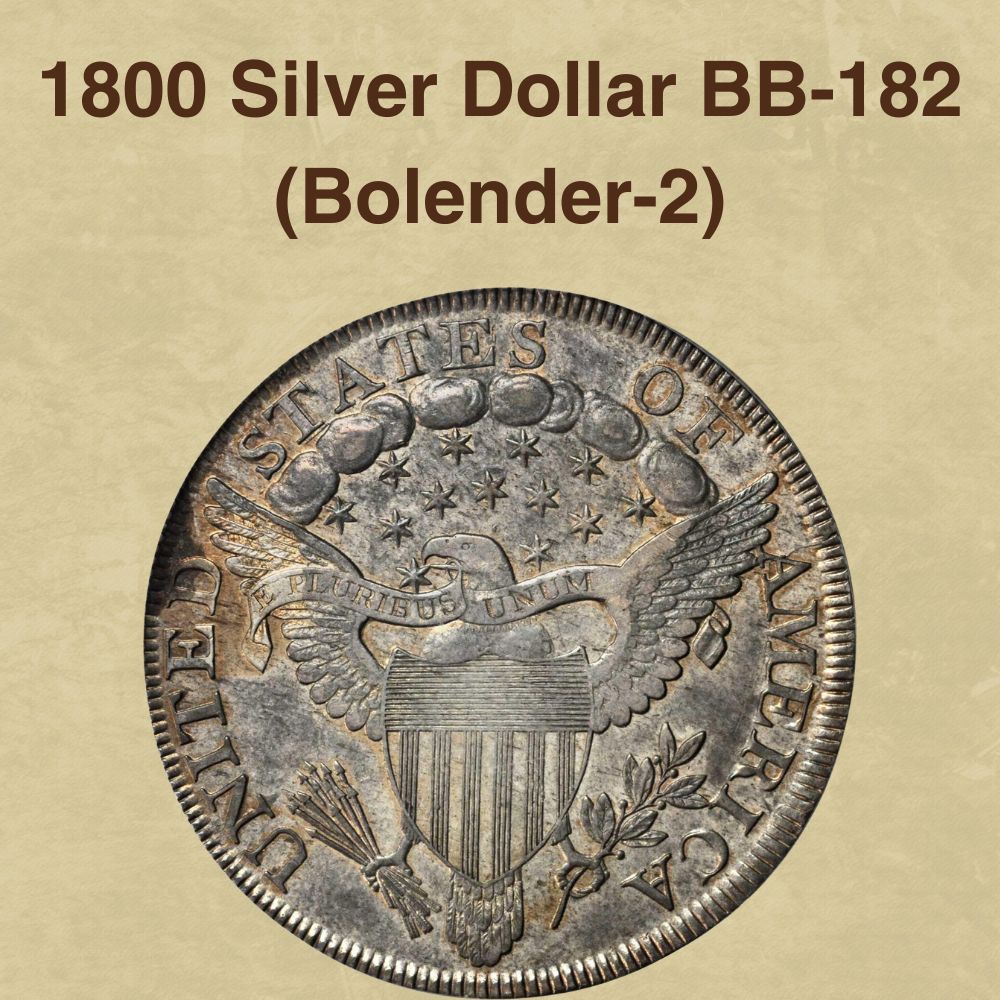
The obverse of this variety shows a more compact “1800” date while Liberty’s portrait shows a sharp, detailed strike. On the reverse, the eagle displays an equally sharp strike, and a well-defined 6×5 star pattern. This variety is relatively popular with values ranging from $3,000 to $15,000 for grades Good (G) through to About Uncirculated (AU58).
6. BB-181 (Bolender-1)

There’s relatively wide spacing between the digits in 1800, with the number 1 appearing further apart from the rest of the digits. On the reverse, the star arrangement is slightly off-center and the overall strike is less sharp. Values for the BB-181 die variety range from $2000-$4000 Good to Fine examples, and up to $10,000 for higher-grade circulated examples.
Where to Sell Your 1800 Silver dollar?
Now that you know the value of your coins, do you know where to sell those coins online easily? Don’t worry, I’ve compiled a list of these sites, including their introduction, pros, and cons.
Check out now: Best Places To Sell Coins Online (Pros & Cons)
FAQ
How to tell if an 1800 silver dollar is real?
Since 1800 silver dollars are prone to forgery, you should pay attention to the coin’s physical features to ascertain that it is real. Assess the diameter (40.00 ml), weight (27.00 g), and the edge (lettered: HUNDRED CENTS ONE DOLLAR OR UNIT). Check that the design elements on the obverse and reverse are balanced, even, and professionally done.
Is an 1800 silver dollar rare?
The 1800 silver dollar is relatively common in circulated states, although survivors are heavily worn due to age and extended exposure. Mint State examples are genuinely rare and Gems are extremely difficult to come across. Remember, 1800 silver dollars had a lower mintage and can be generally rarer than earlier Draped Bust silver dollars.
Is an 1800 Draped Bust Silver Dollar Worth Collecting?
Yes. An 1800 Draped Bust can be a valuable addition to your collection due to its historical status and silver content. Even in lower, circulated grades, an 1800 silver dollar will command premium prices of $1000 upward.
The post 1800 Silver Dollar Value: How Much Is It Worth Today? appeared first on CoinValueChecker.com.















